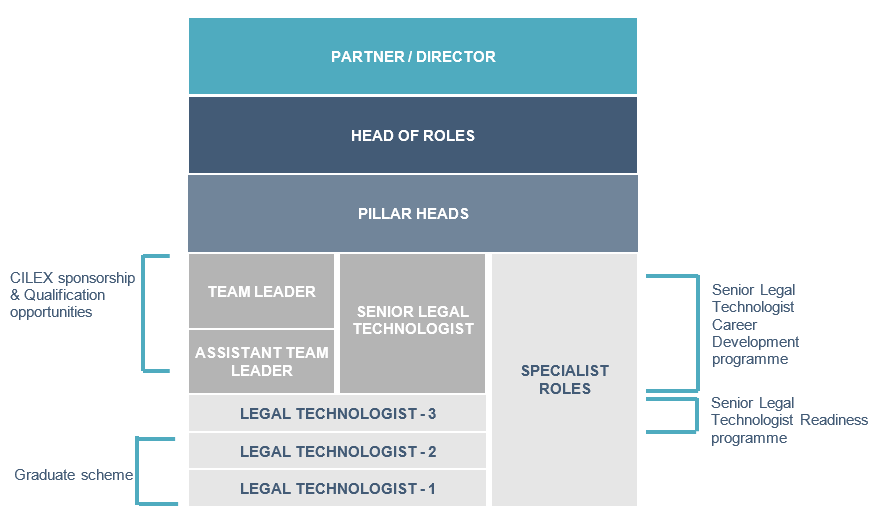When the fledging Innovation and Legal Technology (ILT) team came into existence in 2014 – it was me and one paralegal. Neither of us knew where those initial days would take us. As we slowly brought others into the team, things like structure and career progression became things we needed to think about. And today, now with 36 people it's clear that legal technology and innovation is an area that continues to evolve and brings with it some really exciting career opportunities. This has meant that over the last few months, the leadership team of the ILT have been thinking hard about what the career path in this space looks like and what it offers to those in this role and also those wanting to start a career in legal tech.
We are no stranger to carving new career paths from existing ones, my training contract was done differently, and three of the team who joined us early also did their training contracts in-situ and qualified into ILT. Since 2019 we have also offered trainees an option to do a seat within the ILT – with one of those trainees qualifying with us.
Whilst looking at what it takes to be successful in this space though, it became clear that to have a career in innovation and legal technology doesn't mean you have to qualify.
A new look career path
We put our heads together to work through what a career path could look like. What opportunities can we provide to make this as compelling, exciting and rewarding as doing a training contract for those that want to be lawyers, and how do we attract those who weren't on the legal practice route?
This saw the birth of our Innovation and Legal Technology Career Path. But this isn't just a diagram. There are lots of things that go behind this. It's probably worth saying that it's clear that there are many titles for legal technology/innovation roles in the market and that these titles don't convey everything everyone does – however, ours are called Legal Technologists. Their focus isn't just technology (although it's a huge part) it's about helping to drive change and pushing boundaries in the delivery of legal services.
Since devising our ILT career path for our legal technologists, we've also looked at the ways in which we recruit, develop train and progress our people:

Graduate Scheme
Our first change was to create an Innovation and Legal Technology Graduate Scheme. The scheme is a two-year programme that gives budding legal technologists the ability to rotate around our core pillars in the ILT team giving them insight and grounding into what it takes to help change and innovate the delivery of legal services.
Bespoke Training
From early on we always had different grades of Legal Technologists – what is different now (apart from the Graduate Scheme) is that we have a dedicated induction and training programme relevant to the individual and the level they are. This dedicated programme gives our legal technologists the skills and knowledge needed to deliver successful projects and to progress into the various levels and the expectations for each of those roles. This training includes technical training related to the development of solutions, career development training, legal training as well as product certification.
Progression – Senior Legal Technologist and beyond
As part of the career pathway refresh we created a Senior Legal Technologist Readiness programme which starts when someone reaches our Level 3 Legal Technologist grade (the position someone takes after completing the Graduate Scheme). This programme allows our more experienced Legal Technologists to access opportunities and training aimed at equipping them for the step up to Senior Legal Technologist.
This is important for us as our Senior Legal Technologists are the engine room of our team, so we want those who enter that role to be ready. The Senior Legal Technologists are some of our most experienced people, they lead on projects and initiatives working directly with our clients and colleagues across the business. To facilitate this we have also created a Senior Legal Technologist Career Development programme. Just like the dedicated Legal Technologist training programme this is tailored to the individual and their current level. It gives them the skills to pitch or price for work, to manage a team or to project manage a matter. And we are very clear – this isn't just about ticking attendance boxes on training programmes. It's about taking the knowledge and applying it to the work they do, proving how that training programme is improving the delivery of what we do.
To qualify or not…
We know that a lot of people still do want to qualify as a lawyer. I understand that desire that, after having been through the studying it's still a key career driver for many. So as part of the pathway plan we can also offer those with the right qualifications different legal qualification opportunities. Those who obtain a training contract with the firm who have been a Legal Technologist are able to complete their training contract within the ILT. We actually have one of our longer standing legal technologists starting her training contract with us in September. We can also offer CILEx sponsorship for those that would prefer to qualify through that route and are currently looking at what the changes for the SQE will bring.
It's crazy to think that we'd have reached here when it was just me and Sophie kicking around the idea of an innovation and legal technology focused team… hopefully we are helping to carve out pathways that others will follow – maybe even branching out and creating even less trodden routes.
Members of the ILT will be sharing their career path journeys over the coming weeks – to show how we actually bring this to life.





